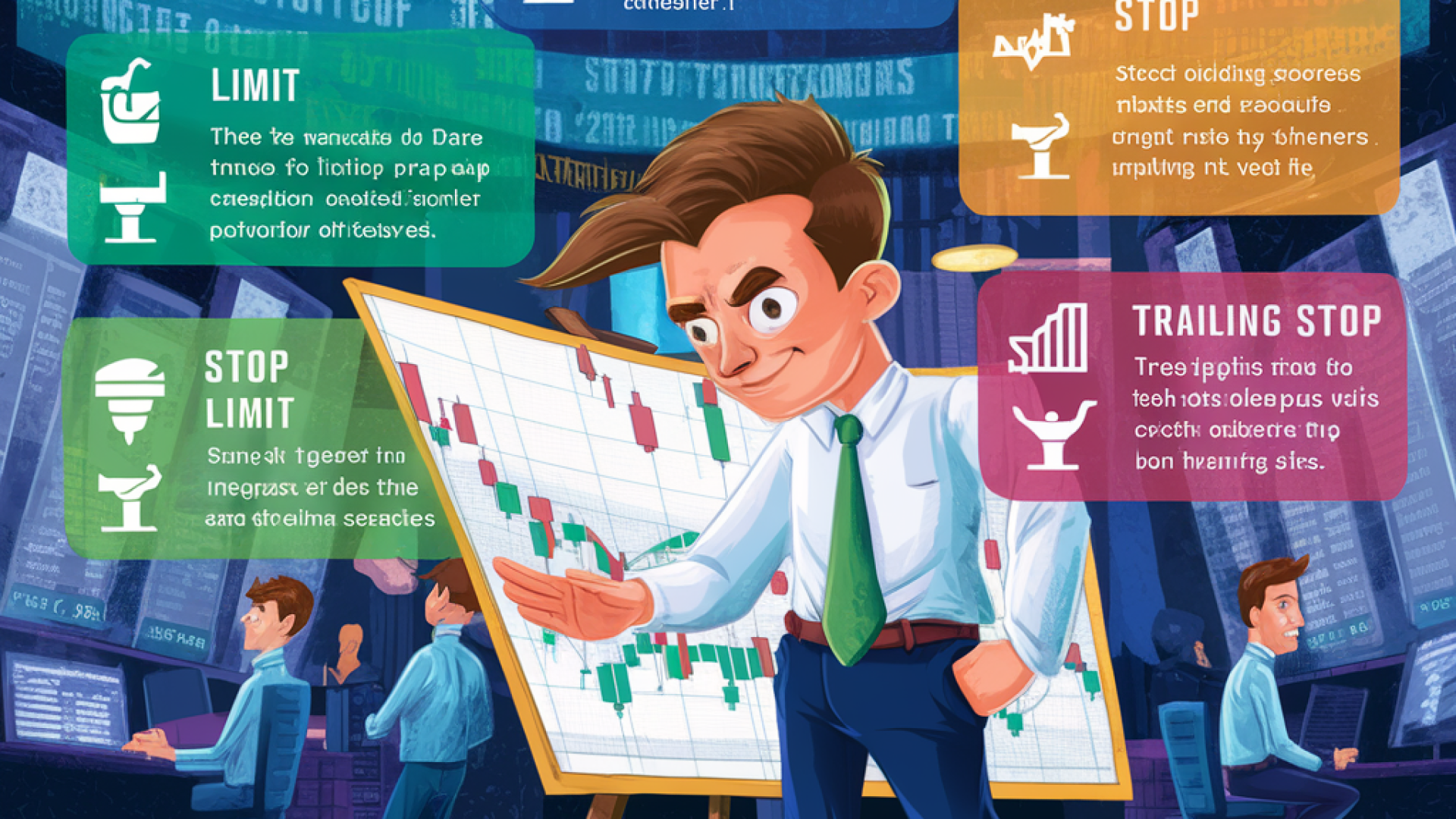Understanding stock market order types is crucial for investors. Market orders facilitate immediate buying or selling, while limit orders ensure execution at a specific price or better.
Stop orders activate market orders when a predetermined stop price is met, offering control over execution. These order types provide flexibility and risk management in trading. Whether you seek instant execution or controlled pricing, understanding these order types is essential for navigating the stock market effectively.
By grasping the nuances of market, limit, and stop orders, investors can enhance their trading strategies and make informed decisions to achieve their financial goals.

Credit: blog.achievable.me
Market Orders
Market orders are essential in the stock market realm, offering immediate execution for buying or selling securities without specifying a price. Understanding the nuances of market orders is crucial for investors seeking swift transactions based on current market prices.
Definition And Execution
A market order is an instruction to buy or sell a security at the prevailing market price. It ensures immediate execution but does not guarantee the specific price at which the order will be filled.
Advantages And Disadvantages
- Advantages:
- Market orders ensure prompt execution, ideal for time-sensitive transactions.
- They eliminate the risk of missing out on an opportunity due to price fluctuations.
- Disadvantages:
- Market orders may lead to unfavorable prices, especially in volatile market conditions.
- There is a lack of control over the exact execution price, which can result in unexpected costs.
Limit Orders
Understanding stock market order types is crucial for successful trading. One of the most commonly used order types is the Limit Order. It allows investors to set specific conditions for buying or selling their securities at a predetermined price. This article will delve into the explanation and usage of Limit Orders, as well as the differences between Buy Limit and Sell Limit orders.
Explanation
A Limit Order is a type of order used to buy or sell a security at a specific price or better. When placing a Limit Order, the investor sets the maximum price they are willing to pay when buying or the minimum price they are willing to accept when selling.
Usage
Limit Orders are utilized by investors who want to have more control over the price at which their trades are executed. By setting a specific price, investors can ensure that they don’t buy or sell a security at an undesired price point, especially in volatile markets.
Buy Limit Vs. Sell Limit
When using a Buy Limit order, the investor instructs their broker to buy a security at or below a specified price. On the other hand, a Sell Limit order is used to sell a security at or above a specified price.
Stop Orders
In the world of stock trading, understanding different order types is crucial for successful investing. One popular order type is the stop order, which allows traders to set specific conditions for buying or selling stocks. Stop orders can be a valuable tool for managing risk and executing trades at desired price levels. In this section, we will explore the function and purpose of stop orders, as well as different types of stop orders.
Function And Purpose
A stop order is primarily used to minimize losses or protect profits. It is an instruction given to a broker to execute a trade when the price of a stock reaches a specified level, known as the stop price. Once the stop price is reached, the stop order is triggered, and the trade is executed as a market order.
The main purpose of a stop order is to manage risk by limiting potential losses. For example, imagine you own shares of a stock that you bought at $50 per share. To protect yourself from a significant loss, you can set a stop order with a stop price of $45. If the stock price drops to $45 or below, the stop order will be triggered, and your broker will sell the shares at the best available market price.
On the other hand, stop orders can also be used to lock in profits. Let’s say you own shares of a stock that you bought at $50 per share, and the stock price has risen to $70. You may want to set a stop order with a stop price of $65 to secure some profit. If the stock price drops to $65 or below, the stop order will be triggered, and your broker will sell the shares at the best available market price, allowing you to cash in on the gain.
Different Types Of Stop Orders
There are several types of stop orders that traders can use depending on their specific goals and strategies:
- Stop Market Order: This is the most common type of stop order. It becomes a market order to buy or sell a stock when the stop price is reached. The trade is executed at the prevailing market price, which may differ from the stop price.
- Stop Limit Order: This type of stop order combines features of both stop orders and limit orders. When the stop price is reached, it becomes a limit order to buy or sell a stock at a specified price or better. This ensures that the trade is executed at the desired price or a better price, but it may not be executed if the specified price cannot be met.
- Trailing Stop Order: A trailing stop order is a dynamic stop order that adjusts the stop price as the stock price moves. It allows traders to capture potential gains by keeping the stop price a certain percentage or dollar amount below the highest stock price since the trail was set. If the stock price drops by the specified trail amount, the stop order is triggered.
Each type of stop order has its own advantages and considerations, and traders should carefully evaluate their trading goals and market conditions to determine which type of stop order is most suitable for their needs.
Stop-limit Orders
Stop-limit orders are a type of stock market order that combines features of both stop orders and limit orders. This order type allows investors to specify a stop price at which the order is activated, and a limit price at which the order is executed.
It provides greater control over the execution price, but there is a risk that the order may not be filled if the market does not reach the specified limit price.
A stop-limit order is a type of order that combines the features of a stop order and a limit order. This order type is designed to provide investors with more control over their trades by allowing them to specify both a stop price and a limit price.
Definition And Application
A stop-limit order becomes a limit order once the specified stop price is reached or surpassed. This means that the investor will only buy or sell the stock at the limit price or better, providing a level of price protection. These orders are commonly used to limit losses or protect gains on a security position.
Comparison With Other Order Types
Compared to a stop order, a stop-limit order provides more control over the execution price, as it allows investors to set a specific price at which they are willing to trade. This distinguishes it from a market order, where the price of execution is not guaranteed, and from a limit order, where the execution is not guaranteed at all.
Choosing The Right Order Type
Choosing the right order type is crucial in the stock market to ensure effective execution of your trades. Understanding the differences between market orders, limit orders, and stop orders is essential for making informed investment decisions. Let’s delve into the factors to consider when selecting the appropriate order type.
Factors To Consider
- Investment Goals: Determine whether you aim for quick execution or specific price targets.
- Risk Tolerance: Evaluate your risk tolerance level to decide on the type of order that aligns with your comfort level.
- Market Conditions: Consider volatile market conditions that may impact the execution of your order.
Market Order Vs. Limit Order Vs. Stop Order
Each order type serves a distinct purpose based on your trading objectives. Here’s a brief comparison:
| Order Type | Description |
|---|---|
| Market Order | An order to buy or sell a security at the current market price. |
| Limit Order | Specifies a price at or better than the specified limit for the trade execution. |
| Stop Order | Automatically triggers a market order when the stop price is reached. |
Consider your investment strategy, risk tolerance, and the prevailing market conditions to determine which order type aligns best with your trading goals.

Credit: www.youtube.com
Practical Tips For Order Placement
Risk Management Strategies
- Always set stop-loss orders to limit potential losses.
- Diversify your portfolio to spread risks.
Examples Of Order Placement
Consider the following when placing orders:
- Use limit orders for precise entry and exit points.
- Implement trailing stop orders for dynamic risk management.
| Strategy | Implementation |
|---|---|
| Diversification | Invest in different asset classes to reduce risk. |
| Stop-Loss Orders | Set predefined price levels to minimize losses. |
| Order Type | Best Use |
| Market Orders | For immediate execution at the market price. |
| Limit Orders | Specify a price or better for order fulfillment. |
:max_bytes(150000):strip_icc()/stop-limit-order-2c639b575958430095e5031c359ed390.jpg)
Credit: www.investopedia.com
Frequently Asked Questions
What Are The 4 Main Types Of Orders In Stock Market?
The four main types of orders in the stock market are market orders, limit orders, stop orders, and stop-limit orders. Market orders are for immediate buying or selling, while limit orders specify a specific price. Stop orders are triggered when a certain price is reached, and stop-limit orders combine stop and limit orders.
What Is The Difference Between A Stop-limit Order And A Market Order?
A stop-limit order allows specifying a price limit, while a market order is executed at the current market price.
What Are The Three Types Of Limit Orders?
The three types of limit orders are Buy Limit, Sell Limit, Buy Stop, and Sell Stop.
Should I Buy Stocks At Market Or Limit?
For large-cap stocks, use market orders; opt for limit orders for thinly traded or volatile assets. Market orders are common in stock transactions.
Conclusion
Understanding different stock market order types is crucial for successful investing. Whether you opt for market, limit, or stop orders, each has its unique purpose. With this knowledge, you can make informed decisions to maximize your investments and minimize risks.
Mastering these order types can significantly improve your trading strategy.

Pavel Zelenka is a seasoned expert in the realms of long-term and value capital investment, as well as angel investing. With a robust background in finance and strategic investment, Pavel Zelenka has distinguished herself as a trusted advisor in the dynamic landscape of wealth creation. Her expertise in long-term investment strategies involves a meticulous approach to identifying opportunities that align with sustained growth and value creation over time. Additionally, Pavel Zelenka excels in valuing capital investments, employing a comprehensive understanding of market trends and asset valuation to guide her decision-making process.
Furthermore, as an angel investment expert, Pavel Zelenka actively engages in supporting and nurturing early-stage ventures. Her keen eye for promising startups, coupled with a strategic approach to angel investing, positions her as a valuable mentor for entrepreneurs seeking not just financial backing but also strategic guidance. Pavel Zelenka’s contributions to the fields of long-term investment, capital valuation, and angel investing underscore her commitment to fostering sustainable growth and innovation in the financial landscape.


